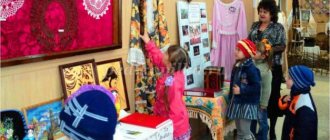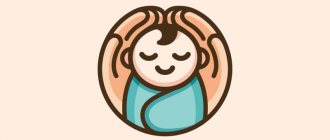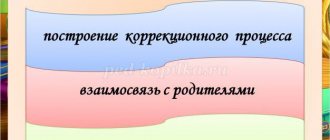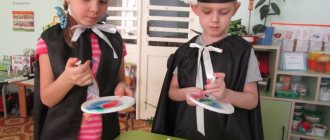Collecting in kindergarten. From work experience
Collecting is a form of organizing cognitive and research activities of preschool children
Author: Tatyana Ivanovna Valisevich, kindergarten teacher Place of work: Kindergarten No. 206 of JSC Russian Railways Purpose: This information will be of interest to educators and parents. Program content Goal: Development of cognitive and research activities in preschool children through collecting. Objectives: To develop an emotional and cognitive attitude towards the world around us. Strengthen children's ability to observe and compare. Develop the creative potential of students. Replenish the subject-development environment with collecting materials. Description: This information allows you to understand how significant the collection is for a child. Nowadays they write and talk a lot about the subject-development environment of children, both at home and in kindergarten. We decided to expand this topic a little in our group by asking children and their parents to share their collections for a while. There are so many new and interesting things you can see when playing with her in a group. When a child collects a collection at home and only he plays with it, this is one way of learning about the subject-development environment. But if he brings his collection to the team, he will see and hear a lot of interesting things both about it and about his best qualities, since few adults would dare to entrust their “treasure,” not to mention children. It is impossible to express in words how passionate the children are about the game; even the owner of the collection himself discovers something new. My children are 3-4 years old and in order to occupy them with something interesting for 20 minutes, I still have to try. But with collections, this does not happen; children play for 20-30 minutes without leaving it. Naturally, I myself am busy with them. Kindersurprise collections are especially popular. Three children brought such collections, and everyone found something new and unusual. If it were possible to insert a video, then everyone could see and hear what kind of dialogue the children are having, how they act out, invent, name toys and much more interesting things. And so I want to share with you the photographs I took while playing with the collections.
We recommend watching:
Project in the senior group of a kindergarten Abstract of a scientific and educational activity with elements of experimental research activities in the senior group, compensating for example Collecting in kindergarten Optimization of cognitive and speech development of preschool children through collecting
Similar articles:
Dance festival in kindergarten for children 5-7 years old. Scenario
Outdoor games as a means of harmonious development of a child
From work experience. Nurturing a culture of verbal communication in preschoolers
How to write a character reference for a child in kindergarten
Features of the intellectual development of preschool children
MAGAZINE Preschooler.RF
Hello! I, Vagan Irina Evgenievna, have lived and worked as a teacher for more than 25 years in Norilsk, Kayerkan district, MBDOU “Kindergarten No. 36 “Polyanka.” While working in a kindergarten, I noticed that children rarely come to the group empty-handed. It can be candy wrappers, postcards, small or even large toys, inserts, sea souvenirs... Whatever is kept in the pockets of our children. They collect figures from Kinder surprises, chewing gum inserts, or even something completely unimaginable. But, undoubtedly, they like to collect. Almost every naughty girl or nimble boy will have a handbag or a box with seemingly unnecessary rubbish: rags, buttons, stones, pieces of glass, wheels, lids. For a child, this is real wealth, a priceless treasure. But, if the baby cannot yet collect something seriously and systematically on his own, it makes sense to help him with this. Therefore, we have been introducing children to collecting for several years now.The Explanatory Dictionary defines collecting as “a systematic collection of homogeneous objects representing scientific, artistic, literary, etc. interest". Our collections began with the “Natural Material” collection, thanks to which many interesting crafts, compositions, and applications appeared in the group. Our group successfully held exhibitions of works by the Egorov family using natural materials “Autumn Waltz”, “Winter Fun”, “Colors of Summer”. The next collection was proposed to be collected by children - “Sea Collection”, parents, friends, and teachers got involved. Collecting shells is one example of how you can build a collection with your kids without spending much money on it. In addition to all the positive aspects of any collecting, such collecting has an additional advantage: it makes the child a more attentive, thoughtful observer, teaches him to love and take care of the surrounding nature, broadens his horizons: (D/game “What's extra.” (Classification by size). Construction by design from shells: “At the bottom.” Modeling from shells using materials from other collections: “Miracles, and that’s all...”). In our group there is a collection of “Buttons”, the grandmothers especially supported it, they helped select the material and designed the collection at home and in the garden together with the children. “The Wrappers Collection” continues to be a success with our children. We made paper blankets, rugs, napkins, crowns from candy labels or chocolate wrappers, and did decorative painting. Then we divided the collection into themes and designed an album together with the children. The collection is constantly growing, replenished with more and more new exhibits. The “My Favorite Calendar” collection also evoked a huge response from children and parents, we systematized it and used it in work on speech development, moral, and aesthetic education: D/game “Guess the Animal”, “Who Eats What”, “Guess by Description” , “Where the hero comes from.” The group has created a “Collectors Club”, with the help of which the collections live and are constantly replenished. Exhibitions of collections were organized for the children of our kindergarten: “In the world of insects”, “At the bottom”, “My favorite calendar”, “Natural”. Based on the collections, exhibitions of children's works were organized: “Green Planet”, “Miracles, and nothing more”, “Decorative collage”, “Gifts for mothers”, “Miracle - vases” (with the active participation of parents). The house has created its own collections: “Stamp Collection” (Karaulov Family), “Badge Collection” (Korsakov Family). While collecting a collection, the child is engaged in cognitive and research activities, and he has a desire to learn more about the items in his collection. The child trains memory, attention, intelligence, develops accuracy and thrift. And by showing his collection to friends, exchanging interesting exhibits with them, the baby learns to communicate. Sincerely, Irina Evgenievna.
| Next > |
Natural materials
Adults and children really like DIY crafts for preschoolers made using natural materials.
Initially, they need to be collected by taking pleasant and healthy walks in the fresh air. Depending on the idea, you may need:
- Leaves of trees, bushes of different shapes and sizes;
- Chestnuts;
- Cones;
- Acorns;
- Small branches;
- Much more.
After taking a fascinating walk, adults and children will be able to find beautiful materials, while at the same time observing and studying nature.
Simple craft options include:
- Painting from leaves. You can depict different animals: a fox, a hedgehog, a wolf. Initially, a drawing is made on a sheet of cardboard. Separately mark the areas where the leaves will be laid out. In the case of a hedgehog, you should draw a face with eyes, a mouth and a nose, and lay out the body from leaves. To do this, you should choose leaves of suitable shape and size, which are glued to the cardboard with glue.
- Application. For a crafts competition for preschoolers, a good idea would be to create a picture using the appliqué technique. To do this, you will need a cardboard base, seeds, leaves, colorful paper, markers, and plasticine. The character himself is initially drawn on cardboard. The drawing should be large enough to make it easy to place different elements. When the drawing is ready, you can start making the applique itself. The hedgehog's body is made of plasticine. The seeds are then attached to it. They should be inserted in a certain order so that everything turns out neatly. The remaining parts of the character's body can be drawn using a felt-tip pen or glued using the applique technique.
- Owl. If you find some pine cones during your walk, you can easily make a cute owl from them. For this you will additionally need plasticine, felt or paper. Initially, a cone of suitable shape and size is selected. It is better if it is a little elongated. Making eyes is not difficult from felt or paper. Parts of suitable size are created from these materials. They are attached with glue. Leaves are suitable for bird wings. The legs are sculpted from plasticine. Legs made from small sticks will also look interesting.
Leaves and other natural materials add special beauty to the work, and creating with them is a pleasure.
“Our Collection” GCD with children of the senior group
Author - compiler:
Polivyanova Lyudmila Gennadievna,
teacher of the highest qualification category
MADO kindergarten No. 42 in Tyumen
Summary of joint educational activities with children of the senior group “Our Collection”
GOAL: To develop the communicative qualities of children through cognitive and research activities.
OBJECTIVES: To develop the ability to examine objects by size, color, and touch. Strengthen the ability to obtain information about a new object during the research process. Expand your understanding of the properties of stone. Give children an idea of how people use stones in their lives; introduce you to natural semi-precious stones.
MATERIAL: stones of different shapes, colors, feel. Trays with pieces of plasticine; with sugar cubes; sticks; 2 glasses each transparent; water; jewelry box,
half-drawn pictures of different subjects.
Activities with children:
Educator: Guys, this morning I remembered our discovery, what did we find on the walking area?
Children: We found an unusual stone.
Educator: What did we decide to do next? Statements and versions of children: Collect a collection of stones, bring them to the group, make a craft, paint them.
Educator: You are so great, you brought so many stones, I didn’t even expect it. Let's remember where you found your finds? Statements and versions of children: on the way to kindergarten, at the dacha, brought from the sea.
Educator: Did you find it yourself or did someone help you? Statements and versions of children: we searched with the whole family, my sister helped me, I noticed it myself. Many people pass by and don’t see anything around them, but you are so great, so what can we say about you, what are you like? Children's statements: observant, inquisitive... Do you want to see what collection of stones you have collected?
Educator: I invite you to our research laboratory. (Children come to the table, different stones are laid out on it according to origin, color, shape, texture).
Educator: How many stones are there, what can you say about them? What are the pebbles in size, color, and feel? What are they like?
Statements and versions of children: they are different in color, big and small, smooth and rough... Now let's draw a conclusion: stones are big and small; smooth, rough; dark, light.
Educator: For the next experiment, take a piece of plasticine in one hand and a stone in the other, squeeze both palms and release them, what happened to the plasticine? What about the stone? What conclusion can be drawn?
Children's statements: the plasticine changed its shape, but the stone remained the same, because the stone is hard and the plasticine is soft.
Children's statements: Researchers, what do you think if a stone is placed in water, what will happen to it? We need evidence, what needs to be done for this? Let's conduct an experiment: lower a stone into a glass of water. Indeed, the stone sank. Why do you think? What is the conclusion?
Children's statements: the stone is heavy, so it sinks.
Educator: Do you want to know whether a stone dissolves in water or not? I propose to conduct an experiment: in front of you are two glasses of water; We put a piece of sugar in one glass and a stone in another, mix and see the result. What happened? What's the conclusion? Children's statements: the sugar dissolved, but the stone did not, because it is very hard.
Educator: Tell me, can young researchers make sounds? Shall we check? Place the stone on the table and listen, what do you hear? And if we hit a stone against a stone, can we hear any sounds? What is the conclusion? Children's statements: Stones can make sounds when they move.
Educator: Guys, what new have you learned about the stone? Yaroslav, what’s interesting, what will you tell Tatyana Viktorovna to your friends, what impressions will you share?
If stones are so strong and hard, where do people use them? Statements and versions of children: in the construction of buildings, bridges, monuments. And guys, people make jewelry out of stones. These stones are called precious and semi-precious (Display of jewelry with semi-precious stones from a box, children touch and examine). How can you and I use pebbles? (play, paint). For example, the game “Guess which hand?”
Educator: Look, guys, I have several paintings, but each painting is missing something. How can we improve the situation? Statements and versions of children: complete the drawing with paints, pencils, lay out the plot with stones of different colors and sizes.
An interesting idea, we use stones to create unusual paintings.
Productive activities of children. Children are divided into teams, choose a picture to choose from and collectively complete it by decorating the composition with stones.
Educator: Well done, everything turned out very nicely for all the teams, I propose to continue collecting our collection, choosing especially interesting stones for this.
Bibliography:
- Program “From birth to school”, ed. N.E. Veraksa 2015 N.A. Ryzhova “Me and Nature”, Moscow 1996
- N.A. Ryzhova “Environmental education in preschool institutions: theory and practice”, Moscow 1999
- T.M. Bondarenko “Ecological activities with children 6–7 years old”, Voronezh 2002
- T.N.Zenina “Lesson notes on familiarizing preschoolers with natural objects” (preparatory group), Moscow 2008
- A.I.Ivanova “Methodology for organizing environmental observations and experiments in kindergarten”, Moscow 2007
Internet resources:
https://open lesson.rf/articles/602705/
https://www.maam.ru/detskijsad/konspekt-nod-my-yunye-isledovateli-dlja-detei-podgotovitelnoi-grupy.html
https://www.maam.ru/detskijsad/konspekt-otkrytogo-nod-po-yeksperimentirovaniyu-v-starshei-grupe-klub-yunyh-isledovatelei.html
https://www.maam.ru/detskijsad/konspekt-organizovanoi-obrazovatelnoi-dejatelnosti-s-yelementami-yeksperimentirovanija-my-isledovateli.html
“Certificate of publication in the media”: Series A No. 0004357
We invite teachers of preschool education in the Tyumen region, Yamal-Nenets Autonomous Okrug and Khanty-Mansi Autonomous Okrug-Yugra to publish their teaching materials: - Pedagogical experience, original programs, teaching aids, presentations for classes, electronic games; — Personally developed notes and scenarios of educational activities, projects, master classes (including videos), forms of work with families and teachers.
Why is it profitable to publish with us?
1. “Kindergartens of the Tyumen Region” is an officially registered specialized media outlet at the federal level. 2. The activities of the editorial office are supported by the Department of Education and Science of the Tyumen Region 3. We issue a “Certificate of Publication” in the media. 4. The document has a unique number, is entered in the register, has the original seal of the editorial office of the online publication and signature. 5. “Certificate of publication” in the media is sent to the author in both paper and electronic versions.
Details >>>
Sample “Certificate of publication of author’s methodological material in the media.”pdf
Share



